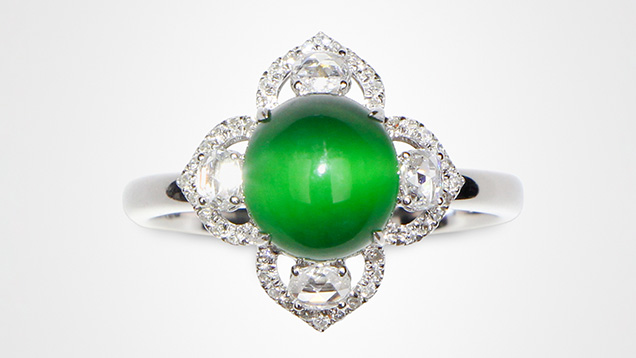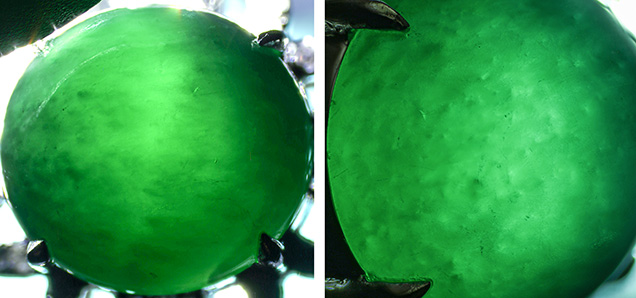Unusual Cat’s-Eye Omphacite Fei Cui Jade

A round cabochon set in a ring with round brilliant and rose-cut diamonds (figure 1) was recently submitted to the National Center of Quality Inspection and Testing on Gold-Silver Products (NGGC) for examination. The center stone, measuring approximately 7.4 × 7.0 mm in diameter, possessed a vivid green bodycolor and exhibited pronounced chatoyancy with a vibrant green sheen. FTIR analysis (figure 2) revealed that the stone was natural untreated omphacite-type fei cui jade, with a typical fingerprint spectrum corresponding with omphacite, a broad absorption band centered at 3500 cm–1 caused by the hydrous interstitial minerals, and the functional group region showing no absorption of any organic filling material commonly used in bleaching and filling treatment, such as Bisphenol A epoxy resin. Subsequent micro-Raman imaging and spectroscopic analysis confirmed the sample as a fairly pure omphacite aggregate, considering that no other mineral impurity was observed or identified (figure 3). The strongest Raman peaks at 682 cm–1 and 1023 cm–1 were attributed to symmetrical Si-Ob-Si stretching/bending and symmetrical Si-Onb stretching, respectively. Ob refers to the bridging oxygens, while Onb represents non-bridging oxygens in silicon tetrahedra.


Element analysis with energy-dispersive X-ray fluorescence (EDXRF) showed that the sample’s major elements were silicon, calcium, aluminum, magnesium, and iron, consistent with omphacite, whose IMA formula is (Ca,Na)(Mg,Fe,Al)Si2O6). It is well known that the Fe2+-induced grayish bluish green bodycolor is most common among the green omphacite varieties. However, this chatoyant sample was characterized by a relatively high chromium content (Cr2O3 ≈ 0.22 wt.%), producing a more saturated and purer green bodycolor rather than a dull green one. This color feature was confirmed by UV-Vis-NIR spectroscopy, with only a single transmittance band centered at 535 nm appearing in the visible range (figure 4).

Microscopic observation with finely tuned fiber-optic light revealed a parallel-arrayed fibrous texture throughout the sample (figure 5). Meanwhile, a vague honeycomb-like pattern was observed at two specific sides near the girdle (the 12 and 6 o’clock positions of the cabochon in figure 1). Thus, under reflected light the stone presented a chatoyant sheen parallel to the ring band.

Based on our current knowledge, this green omphacite fei cui jade was probably from Guatemala. Translucent fei cui jade with such fine texture, vivid green bodycolor, and even color distribution has always been considered of high quality and rarity, but the chatoyancy of this sample offered additional value.



